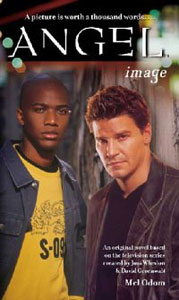The competition is on: Is Jeff Mariotte or Mel Odom the best “Angel” novelist? At this point in my re-read, Odom moves out in front with “Image” (April 2002), the best “Angel” novel so far. It has a lot going on, but everything is meaningful. Angel, Cordelia, Wesley and Gunn have warmed up to each other again after Angel’s Season 2 dark period, which lingered in Mariotte’s “Haunted.” “Image” feels entirely like an “Angel” episode, yet it has the heft of a novel … yet the scope doesn’t get too big and overshadow the TV series’ events; that’s the highest compliment I can give to Buffyverse spinoff fiction.
This is just a small portion of the book, but I find it cool that Angel and Darla knew Lord Byron and his friends, including Mary Wollstonecraft Shelley, who wrote “Frankenstein” – considered by many to be the first science fiction novel – 200 years ago. “Image” imagines that a monster from another dimension – a rival of Angel’s and Darla’s – terrifies Mary and inspires her to write “Frankenstein.” (Interestingly, there are also “Angel vs. Frankenstein” comics, so somehow both Shelley and her fictional creations exist in the Angelverse).
Speaking of classic literature, the main villain comes from inside a painting, something with “Dorian Gray” overtones. It also reminds me of the “Donatello” one-shot from Mirage’s “Teenage Mutant Ninja Turtles” comics. Odom ties this in with a delicious passage where Angelus and Darla oh-so-slowly save an artist from his tormentors, who are dangling him over the side of a bridge, on the condition that he paint Darla’s portrait.
Despite all these supernatural elements and flashbacks to the old-time Europe that was Angelus’ stomping grounds, “Image’s” overall tone is that of hardboiled fiction, with its snapped-off dialog. This is emphasized in Gunn’s arc, where he becomes interested in the travails of a femme fatale, Faroe, whose painting abilities eventually tie in with the book’s backstory. As “Image” begins, Gunn is working out in a boxing gym, and one of the attendants is reading a “Daredevil” comic, Odom’s nod to his influences on this story. Faroe lives in apartment above the gym, and while there is something between her and Gunn, she also resists his help.
Cordy also has a nice arc where she aggressively pursues the mystery of her own vision because it involves an innocent young boy, and Wes is in character as he is concerned about the reputation of Angel Investigations.
“Image” finds room for humor, particularly in a sequence where Wes and Cordy desperately recruit Merl, the entertainingly sniveling informant demon who appears in six episodes of “Angel.” The trio’s attempt to get information from questionable tabloid journalists somehow devolves into Merl doing a striptease, and then a fight against a giant slime demon. The next chapter finds Cordy trying to get the slime out of her hair, and Wes is still covered in it as he waits to use the shower. Yet the gang is studiously mulling the next step of the case at the Hyperion Hotel desk. Odom never sacrifices story momentum for details, or vice versa.

From the category of nitpicks: The Host is known as Lorne in this novel, which is a continuity glitch. The gang learns his name in “Belonging” (2.19), but “Image” is most likely set before that episode, which kicks off the four-episode Pylea arc that closes Season 2 and introduces new Angel Investigations team member Fred. And Wesley’s last name is misspelled in this book, Wyndham-Pryce instead of the correct Wyndam-Pryce.
Such is the quality of “Image” that I forgive those flaws.
Click here for an index of all of John’s “Buffy” and “Angel” reviews.

